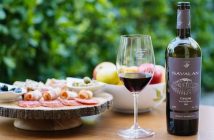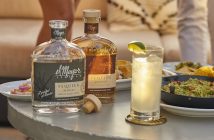Cavatast is a bit of an odd name for us Anglophones. Think of it as either “Cava Taste” or “Cava Fest” and you get the picture. Cava is, of course, Spanish champagne and it uses the samemethode champenoise. Unlike Prosecco (made in massive steel tanks) but just like champagne, Cava is fermented in the bottle. In fact, that’s how it got its name.
Originally, the sparkling wine produced here was simply called Champagne but when Spain joined the EU, they had to change the name as it was already a French appellation controllee. So they started off calling it something roughly translated as “sparkling wine fermented in the bottle and aged in the cave”. This was a bit of a mouthful so it got shortened to the last word – cave or, in Spanish, cava.
The capital of Cava is Sant Sadurni d’Anoia in the Penedes region and just some 30 miles from Barcelona. This is the home of Cavatast, a three-day October celebration of the wine and all kinds of other local produce. Everyone literally sets out their stall in the main street and you wander up and down with a glass being refilled along the way, while eating tapas. What could possibly be nicer?

You can visit the vineyards all year round. At Codorniu, the oldest, biggest and indeed grandest winery in the region, you can take a tour around the cellars and sample the final results at the end. This is, in fact, Spain’s oldest family business (around 450 years) and the buildings and gardens are glorious. The cellars are so vast you take a train ride through the columns of stacked dusty bottles, all carefully labelled, past the disgorgement machines (where the yeast sediment is removed from the bottle before it receives its final cork) and you end up in the bar where you not only taste but get a lesson on how to serve Cava.
Serving Cava: The Foolproof Guide
- No explosive popping – opening the bottle should be done with a delicate turn of the wrist so the pop is as soft as possible.
- Serve in a tulip-shaped glass to enable the wine to release its flavours and bubbles at their best.
- Neverfreeze Cava.
- Don’t serve it too cold – 5-8C is perfect.

Recaredo is at the other end of the scale in terms of size. This vineyard is not just an organic, it’s a biodynamic and its vines sit below the imposing presence of Montserrat, the mountain protecting them from the North winds. These grapes are produced without any chemical fertilisers or insecticide. Instead they encourage bats (to eat the insects), apply medicinal herbs and make their own compost. The place is full – even in October – of butterflies and the people who work here are passionate about their product. Elena Olesa who shows me round uses the word frequently and introduces me to one of their star “disgorgers” – this is one of the few wineries where every bottle is disgorged by hand rather than machine.
They make only Gran Reserva and that means the wine must rest in the bottle for a minimum of 30 months. Some ferment much longer than that. Down in the cellar we open a bottle of the Reserva Particular de Recaredo. “After 10 years in the bottle,” says Elena, “we are tasting it just as it wakes up. It is very special.” Indeed it is.
Back in Sant Sadurni at Cavatast, some of the tapas is unexpected. Chocolate, for instance. Xocolata Simon Coll has a chocolate factory in town (the whole town smells of chocolate, in fact, how wonderful is that?). Here you can take a tour and enjoy a tasting of chocolate at its different stages of production as well as the final results. There are of course some with a cava centre.

Cheese and wine are a less surprising pairing but Cava and cheese? It’s remarkably good as I discovered with Victor Conejo whose cheese workshop, Xerigots, is in nearby Vilafranca del Penedes. Xerigots is a Catalan word meaning “whey” but it’s also a bit of a play on words as “gots” is glass and in his shop, cheese and wine go very much together – his combined tastings are a tour de force.
The Penedes region is full of small traditional towns, pretty and full of character. Vilafranca is particularly interesting with its combination of Gothic and Art Nouveau architecture. Its Vinseum – a museum of Cava – faces the town’s magnificent Santa Maria church and is housed in the Palau Reial (royal palace) that dates from the 13thcentury. Here they have traced the making of Cava back at least 2700 years. The proof is 400 carbon dated grape seeds found in a nearby vineyard.
Cava defines this region more than anything. As my museum guide tells me, “Wine here is not an alcoholic drink. It is culture.”
For more information about Catalunya, visit the official Catalan Tourist Board website at www.catalunya.com. For more information about Penedès wine tourism, visit www.enoturismepenedes.cat/en.
Codorniu is available widely but Recaredo is a bit harder to track down. You can find it, though, at Bedales Wines and Brindisa both in Borough Market, Bottle Apostle (95 Lauriston Road, Victoria Park Village, Hackney) and at Selfridges.




